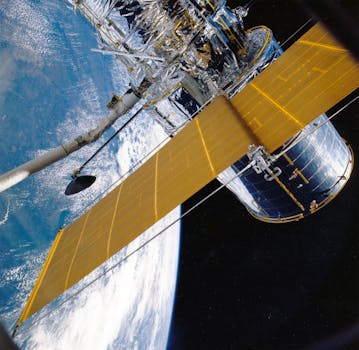
The Future is Now: Exploring the Cutting-Edge Innovations in Satellite Telecommunications
Satellite telecommunications is an area of rapid growth and innovation, with new technologies and advancements being made every year. The focus keyword, Satellite Telecommunications, is at the forefront of this revolution, with companies like SpaceX, Amazon, and OneWeb leading the charge. In this article, we will explore the latest developments in satellite telecommunications and what they mean for the future of communication.
Low-Earth Orbit Satellites

One of the most significant innovations in satellite telecommunications is the development of low-Earth orbit (LEO) satellites. These satellites orbit the Earth at an altitude of around 2,000 kilometers, which is much lower than traditional geostationary satellites. This lower orbit allows for faster communication and lower latency, making it ideal for real-time applications like video conferencing and online gaming.
Companies like SpaceX and OneWeb are launching constellations of LEO satellites to provide global internet coverage. These constellations consist of thousands of small satellites that work together to provide a network of interconnected satellites. This network can provide internet access to remote areas and underserved communities, bridging the digital divide and bringing the benefits of the internet to everyone.
Satellite-Based Internet

Satellite-based internet is another area of innovation in satellite telecommunications. With the launch of LEO satellites, it is now possible to provide high-speed internet access from space. This technology has the potential to revolutionize the way we access the internet, especially in areas where traditional infrastructure is limited or non-existent.
Satellite-based internet works by transmitting data from a user’s device to a satellite in orbit, which then transmits the data to a ground station. The ground station then sends the data to its final destination, whether that be a website, a server, or another user. This process happens in a matter of milliseconds, making it possible to stream videos, play online games, and access cloud-based applications in real-time.
Advanced Propulsion Systems

Another area of innovation in satellite telecommunications is the development of advanced propulsion systems. Traditional satellites use chemical propulsion systems, which are heavy and inefficient. New propulsion systems, such as electric propulsion and advanced ion engines, are being developed to make satellites more efficient and cost-effective.
These new propulsion systems use less fuel and can operate for longer periods of time, making them ideal for deep space missions and long-duration satellite operations. They also produce less waste and are more environmentally friendly, which is an important consideration for the satellite industry.
Conclusion

In conclusion, the future of satellite telecommunications is exciting and rapidly evolving. With innovations like LEO satellites, satellite-based internet, and advanced propulsion systems, the possibilities for communication and connectivity are endless. As technology continues to advance and improve, we can expect to see even more innovative solutions to the challenges of satellite telecommunications.
See more:




